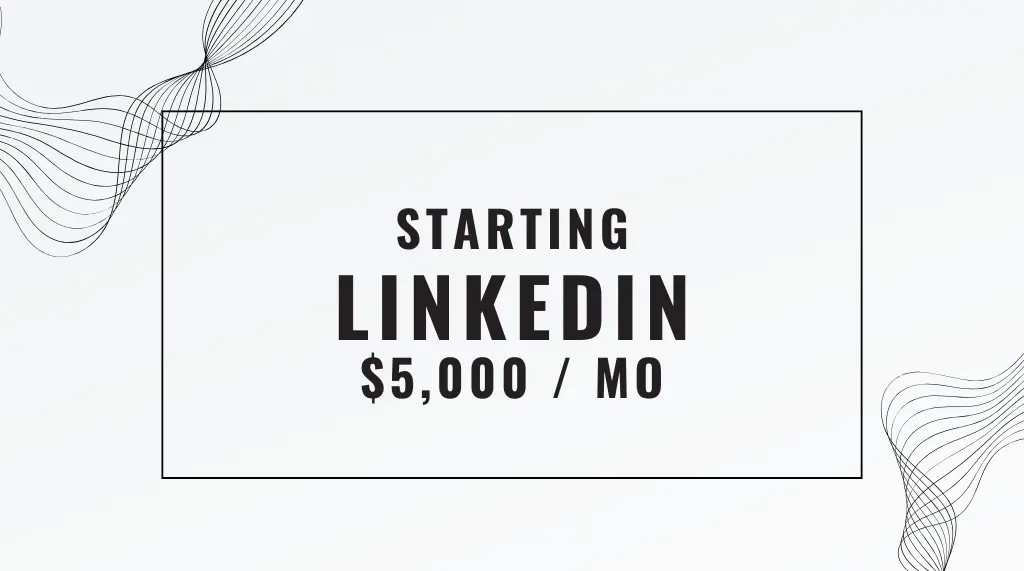If you’ve ever wondered how to build an impactful LinkedIn presence from zero, you’re in the right place. This guide walks through the steps to build your profile, leverage LinkedIn’s unique features, and grow an engaged audience without relying on content creation alone.
Setting Up Your Profile for Maximum Visibility
The first step to building a LinkedIn presence is creating a profile that stands out and serves as a magnet for your target audience. This starts with two key profile elements that everyone on LinkedIn will see: your positioning statement and profile photo.
Crafting an Effective Positioning Statement
Most people fill in their LinkedIn positioning statement with job titles and personal achievements, like “Founder,” “Coach,” or “Consultant.” But LinkedIn users aren’t searching for job titles; they’re looking for solutions to specific problems. This is where the concept of a “Monday morning problem” becomes essential.
A Monday morning problem is the issue that’s top of mind for your ideal client at the start of their workweek. Visualize this: your client plans their week on Sunday, but by Monday morning, they’re already facing obstacles—maybe a key employee just resigned, a sale fell through, or they’re handling a refund request. They’re now in search of someone who can help them tackle these challenges. Craft your positioning statement to highlight exactly how you solve these pressing, relatable issues.
Optimizing Your Profile Photo for Trust and Authority
Platforms like Netflix, Amazon, and major publishers know that first impressions matter, and your LinkedIn photo is no different. An eye-catching, professional profile image can convey authority and approachability in seconds. Ensure your photo rates high on factors like likability and professionalism using a free online rating tool. Aim for a score of 7 or higher on all metrics to make a great first impression.
Day-by-Day Strategy for Finding Your Audience
With the basics in place, the next step is finding and connecting with your target audience. Instead of cold-messaging strangers, which feels impersonal and often leads to dead ends, you’ll be using a more strategic approach that builds on familiarity and trust.
Mapping Your Network
Draw a timeline of your personal and professional experiences. Note each job you’ve held, places you’ve lived, and institutions you’ve been affiliated with. These are your trust-building points, places where shared connections exist. Psychological research shows that people are more likely to trust those with similar backgrounds. By leveraging these shared experiences in your LinkedIn outreach, you can increase your acceptance rate and develop a network of people who view you as familiar and credible.
Making the Right Connections
Once you have your target list, start sending LinkedIn connection requests with a short, friendly message. Avoid pitching your services or linking to content right away. The goal is to establish a genuine connection by showing interest in their work and leaving the door open for future engagement.
Setting the Tone for LinkedIn Conversations
Once people start accepting your connection requests, it’s time to engage them. Conventional wisdom suggests pitching your services or sharing content immediately, but this can come off as pushy. Instead, use a “non-needy” approach that focuses on building rapport rather than self-promotion.
Creating a Non-Needy Framework
Imagine you’ve bought a beautiful piece of art; you wouldn’t display it with duct tape. The same concept applies to LinkedIn conversations. Approach initial messages in a way that showcases your interest without seeming desperate for attention. A simple, friendly message like, “Hi [Name], great to connect! Looking forward to learning more about [something specific on their profile]” is perfect. This low-key introduction establishes a positive frame and encourages a natural flow of conversation.
Building Social Proof and Authority on LinkedIn
Social proof is essential on LinkedIn. Once people connect, they’ll often review your profile to see if you’re someone worth engaging with further. One way to create immediate social proof is by enabling LinkedIn’s Creator Mode and using the Featured section to highlight key posts.
Featuring High-Impact Content
The Featured section allows you to pin selected posts, making them prominent when others view your profile. Start with a “listicle” post—a format that performs well on LinkedIn, particularly if it’s visually engaging. For example, you could create a carousel post listing the top tools or strategies for your industry. You don’t need to spend hours writing; free AI tools can quickly generate lists and help format your post in an eye-catching way.
Leveraging LinkedIn’s Unique Algorithm
LinkedIn’s algorithm is different from other platforms, and understanding it can help you reach a larger audience more quickly. Unlike Instagram, YouTube, or TikTok, LinkedIn doesn’t prioritize viral content across the entire platform. Instead, it shows content to the people already in your network first. If you’re starting with zero followers, that means posting directly to your profile won’t get you very far initially.
Engaging with Influencers to Expand Reach
Rather than posting on your own profile, a faster way to get visibility is by engaging in the comments of large accounts in your industry. When someone with a significant following posts, your comment will be seen by their audience too, especially if you engage early with thoughtful, relevant insights. Spend a few minutes each day finding posts from influencers in your niche and leave insightful comments that showcase your expertise. This approach leverages the visibility of established profiles, creating exposure for your own expertise and profile by association.
For this strategy to work, focus on profiles with over 100,000 followers, who regularly post content with broad appeal. A quick LinkedIn search using keywords related to your industry can reveal influencers worth following. To save time, create a spreadsheet of these influencers and track the times they usually post. Set notifications to engage promptly when they share new content.
Building a Strong First Impression with Featured Content
Your interactions in the comments section will drive traffic back to your profile. When this happens, your profile should immediately convey authority and trustworthiness. In addition to your positioning statement and photo, the Featured section should be strategically curated to display your best content.
Refining Engagement and Building Long-Term Relationships
Once you’ve started establishing your presence, consistency and intentionality in engagement are crucial for sustained growth. Building a strong LinkedIn network isn’t a one-off effort; it’s a gradual accumulation of trust and influence. One way to maintain this momentum is to develop a recurring engagement strategy that connects you with high-potential prospects while nurturing existing connections.
To do this, set aside a few minutes each day to engage with posts from your target audience and industry peers. Instead of simply “liking” a post, add value by offering thoughtful insights or by sharing relevant experiences. This keeps you visible to your connections and helps build a perception of you as a knowledgeable and involved industry professional.
Leveraging LinkedIn Analytics for Strategic Adjustments
LinkedIn provides a wealth of analytics, even for free accounts, that you can use to fine-tune your strategy. Profile views and post engagement metrics are key indicators of how effectively your content and outreach resonate with your audience. For example, if you notice a spike in profile views following a specific post or comment, take note of the post’s theme, format, and timing.
Experiment with these variables to see what works best for your audience. Over time, you’ll discover patterns that allow you to predict engagement, helping you become more strategic and efficient with your content creation. Additionally, LinkedIn’s Social Selling Index (SSI) score, while often overlooked, can give insights into your effectiveness in four key areas: creating a professional brand, finding the right people, engaging with insights, and building relationships. Monitoring your SSI can help you identify areas where you might want to increase focus.
Transforming Cold Connections into Warm Leads
With consistent engagement and strategic messaging, the goal is to turn casual connections into warm leads without the need for heavy-handed pitches. LinkedIn is ideal for gradual lead warming, where you build rapport and establish credibility before a business proposal ever comes into play.
After connecting and engaging periodically, consider sending a direct message that acknowledges previous interactions. For instance, if you’ve exchanged comments on industry posts or reacted to their updates, your message might say, “Hi [Name], I’ve really enjoyed our conversations on [topic or post], and I’d love to hear more about what you’re working on. Perhaps we could exchange a few ideas?” This gentle approach allows you to explore potential collaborations or identify mutual needs without feeling transactional.
Nurturing Long-Term Connections for Referrals
Often, the most valuable aspect of LinkedIn is not just acquiring direct clients but developing a network that refers you to others. This happens naturally when you focus on genuine connection-building over time. For instance, keep an eye on job changes within your network—LinkedIn notifies you when someone in your network has a new role or promotion. Congratulate them and take the opportunity to reconnect. It’s a non-salesy touchpoint that strengthens your rapport and keeps you top-of-mind when they or someone in their network needs your services.
Additionally, LinkedIn’s Recommendations feature can significantly strengthen your credibility. After successfully working with a client or colleague, ask them for a brief recommendation that highlights specific results or attributes of your working relationship. Over time, these recommendations serve as social proof, bolstering your profile for both potential clients and referrers.
Implementing Automation Carefully for Efficiency
While automation tools are available for LinkedIn, using them carefully is essential to avoid appearing spammy or impersonal. For repetitive tasks like sending connection requests or birthday greetings, some professionals use LinkedIn automation tools to streamline their workflow. However, it’s important to make these interactions feel personalized. Avoid templates that look generic or overly promotional, and remember that LinkedIn penalizes users who overuse automation, which can harm your account’s visibility.
A safer approach to automation is semi-automated engagement, where you pre-write responses or introductory messages that you can adapt quickly. This method retains a human touch while helping you manage time effectively. Use automation strategically for scheduling posts or tracking engagement metrics, but keep direct messages and engagement in comments personal and genuine to maintain a trustworthy profile.
Positioning for Long-Term Growth and Authority
The culmination of a strong LinkedIn strategy is establishing yourself as an industry authority. Beyond one-off engagements, aim to become a trusted source of information by offering thought leadership content that tackles industry trends, shares insights, or forecasts potential challenges in your field. These types of posts are more likely to be saved, shared, and commented on, extending your reach beyond your immediate network and positioning you as a go-to resource in your area of expertise.
Consider hosting a LinkedIn Live session if your profile qualifies, or publishing long-form articles to deepen your credibility. LinkedIn Live allows you to engage in real time with your network and answer questions, which can significantly elevate your authority and foster deeper connections. Long-form articles, meanwhile, let you showcase your knowledge more comprehensively and often rank well on LinkedIn’s search engine, increasing your discoverability.
Measuring Success and Adapting for Continued Growth
Your success on LinkedIn is often measured through incremental, ongoing wins. This includes not only the number of new clients or connections but also increased engagement rates, profile views, and endorsements. To measure the impact of your efforts, regularly assess key performance indicators such as profile views, connection growth, post engagement, and message response rates.
Finally, remember that LinkedIn, like any platform, evolves. Stay adaptable by experimenting with new content formats or engagement methods that align with LinkedIn’s latest features and algorithm adjustments. This adaptability ensures that your LinkedIn strategy continues to drive results as the platform grows.
By following these structured, intentional steps, you’re positioning yourself for sustained success on LinkedIn. From initial profile setup to in-depth engagement strategies, each element of this approach is designed to build a powerful, enduring network that supports your professional growth and positions you as an authority in your field. With time, consistency, and adaptability, LinkedIn can become one of your most valuable tools for long-term relationship-building and business development.




